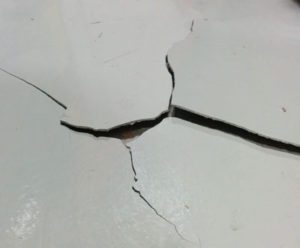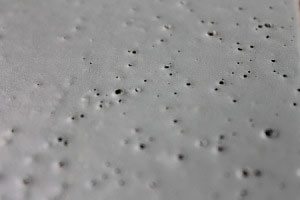We all started somewhere. And in this article I will discuss three mistakes commonly made by beginners. These are mistakes I have experienced in the past and mistakes that I often see made by beginners applying resinous floors. They are common mistakes and can easily be avoided by asking the right questions and doing some background research before starting.
Rushing through the surface preparation
 Surface preparation is probably the most important phase of epoxy flooring. This phase involves cleaning and preparing the substrate so that the resins will properly bond to the substrate. It is also the messiest and least glamorous part of epoxy flooring. No one wants to be toiling away in the dust cleaning greasy floors. Inexperienced contractors are anxious to complete the surface prep quickly so they can move on to the most fun part of actually coating the floor where the results of your work become visible. I consider myself guilty of this mistake. When I first started out all I seemed to care about was seeing the final result (and the fact that customers were also anxious to see the final result didn’t help!).
Surface preparation is probably the most important phase of epoxy flooring. This phase involves cleaning and preparing the substrate so that the resins will properly bond to the substrate. It is also the messiest and least glamorous part of epoxy flooring. No one wants to be toiling away in the dust cleaning greasy floors. Inexperienced contractors are anxious to complete the surface prep quickly so they can move on to the most fun part of actually coating the floor where the results of your work become visible. I consider myself guilty of this mistake. When I first started out all I seemed to care about was seeing the final result (and the fact that customers were also anxious to see the final result didn’t help!).
If you do not properly go through the surface prep phase you will encounter all sorts of problems afterward. Problems include improper adhesion and peeling, surface defects, visible cracks, and the list goes on and on.
Improperly sealing the slab
 Bubbles and pinholes can emerge for many reasons and it is beyond the scope of this article to go into all of them. However, perhaps one of the most common causes for bubbles and pinholes is that porous slabs release trapped air when they are coated over. Ensuring that the slab is sealed and well primed is a great way to reduce the risk of bubbles appearing.
Bubbles and pinholes can emerge for many reasons and it is beyond the scope of this article to go into all of them. However, perhaps one of the most common causes for bubbles and pinholes is that porous slabs release trapped air when they are coated over. Ensuring that the slab is sealed and well primed is a great way to reduce the risk of bubbles appearing.
Not understanding epoxy chemistry
Many people working with epoxies for the first time may have a background in other fields like painting, waterproofing or concrete, and may have a complacent attitude. For example, a common mistake I see among beginners is not understanding how two-component systems work and the mistakes made when mixing the epoxies (see “Epoxy disasters: common mixing mistakes that can lead to curing problems”). In addition, those new to epoxies may not have the sense of urgency needed when it comes to understanding the limited potlife of an epoxy resin compared to other products.
In conclusion, no matter how many years you have been involved in construction, always adopt a novice attitude when entering a new field or an unfamiliar project. I have seen far too many old school professionals give the “I’ve been working 25 years in construction speech” only to cause a major mess-up a little later.
I once had a worker insisting on wetting the concrete before applying the epoxy!
This article was originally published August 29, 2016 by Akis Apostolopoulos on learncoatings and can be found at http://learncoatings.com/wordpress/common-beginner-mistakes-epoxy/.
About the author
Akis Apostolopoulos, General Manager at Ktisis
 Akis has been involved in the manufacturing and application of industrial floor coatings for the past ten years. He runs learncoatings which is an online resource training professionals on the use of epoxy floors. He is also General Manager of Ktisis, a manufacturer of flooring and waterproofing coatings.
Akis has been involved in the manufacturing and application of industrial floor coatings for the past ten years. He runs learncoatings which is an online resource training professionals on the use of epoxy floors. He is also General Manager of Ktisis, a manufacturer of flooring and waterproofing coatings.





